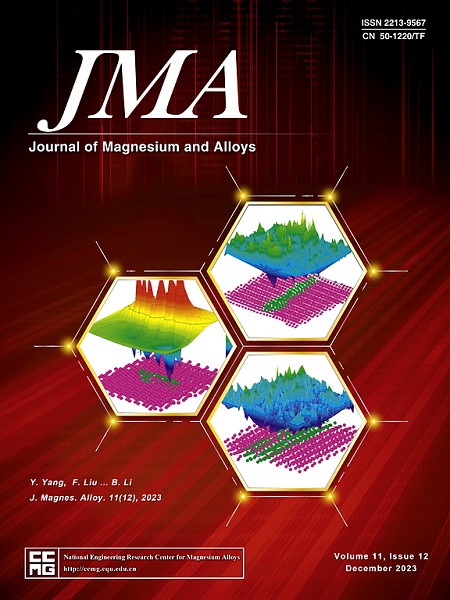通过钉住孪晶界和Guinier-Preston区,稀Mg-Zn-Nd-Ca合金屈服强度和塑性的协同作用
IF 15.8
1区 材料科学
Q1 METALLURGY & METALLURGICAL ENGINEERING
引用次数: 0
摘要
Mg-Zn-RE合金具有非基底织构、弱弥散硬化和低屈服强度的特点。本研究设计了一种稀季系Mg-0.6Zn-0.4Nd-0.2Ca (wt.%)合金。然后,应用预应变和热处理方法,通过孪晶界的溶质原子偏析和纳米相改性来研究屈服强度和塑性的平衡。结果表明:Zn和Nd元素在孪晶界处倾向于共偏析,而Ca元素单独偏析,呈不连续分布;晶粒尺寸为5 ~ 20 nm的(Mg, Zn)3Nd和Mg2Ca在孪晶界处优先析出。此外,与Ca原子相比,Zn原子更倾向于与Nd原子向层错方向结合,从而形成高密度单层Guinier-Preston (gp)带。孪晶界处溶质原子的偏析和析出以及层错增加了孪晶位错和晶格位错的摩擦应力,从而提高了强度。由于几何配合力因子(m′)和施密德因子(SF)不配合力较小,固定孪晶界有利于从基底< a >滑移向锥体< c + a >滑移过渡。结果,与初始状态试样相比,预应变和热处理试样的屈服强度提高了141%,同时延性也有一定程度的提高。详细讨论了双晶界多元素偏析和析出的机理以及gp带的形成。本文章由计算机程序翻译,如有差异,请以英文原文为准。

Synergization of yield strength and ductility for a dilute Mg-Zn-Nd-Ca alloy through pinned twin boundary and Guinier–Preston zone
Mg-Zn-RE alloys typically exhibit non-basal texture, weak dispersion hardening, and low yield strength. In this study, we designed a dilute quaternary Mg-0.6Zn-0.4Nd-0.2Ca (wt.%) alloy. Then, applied pre-strain and heat treatment to investigate the balance of yield strength and ductility via solute atom segregation at twin boundaries and nanophase modifications. The results indicated that Zn and Nd elements tend to co-segregate at the twin boundary, while Ca element segregates alone and presents a discontinuous distribution. Nanoscale precipitates of (Mg, Zn)3Nd and Mg2Ca with the size of 5∼20 nm underwent significant preferential precipitation at the twin boundary. Moreover, compared with Ca atoms, Zn atoms tend to combine with Nd atoms more preferentially towards the stacking faults, thereby forming a high-density monolayer Guinier-Preston (G.P.) zone. The segregation and precipitation of solute atoms at the twin boundary and the stacking faults increased the friction stress of twinning dislocations and lattice dislocations, thus improving the strength. Pinned twin boundaries facilitate the transition from basal 〈a〉 slip to pyramidal 〈c + a〉 slip due to the small geometrical compatibility factor (m′) value as well as the Schmid factor (SF) incompatibility. As a result, the pre-strained and heat-treated specimen's yield strength exhibits a 141 % increase relative to the initial state specimen, accompanied by a modest improvement in ductility. The mechanism of multi-element segregation and precipitation at twin boundaries, and G.P. zone formation was discussed in detail.
求助全文
通过发布文献求助,成功后即可免费获取论文全文。
去求助
来源期刊

Journal of Magnesium and Alloys
Engineering-Mechanics of Materials
CiteScore
20.20
自引率
14.80%
发文量
52
审稿时长
59 days
期刊介绍:
The Journal of Magnesium and Alloys serves as a global platform for both theoretical and experimental studies in magnesium science and engineering. It welcomes submissions investigating various scientific and engineering factors impacting the metallurgy, processing, microstructure, properties, and applications of magnesium and alloys. The journal covers all aspects of magnesium and alloy research, including raw materials, alloy casting, extrusion and deformation, corrosion and surface treatment, joining and machining, simulation and modeling, microstructure evolution and mechanical properties, new alloy development, magnesium-based composites, bio-materials and energy materials, applications, and recycling.
 求助内容:
求助内容: 应助结果提醒方式:
应助结果提醒方式:


